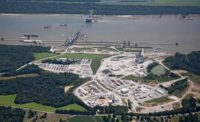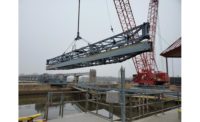On Dec. 28, crews placed the final concrete shell in the Olmsted Locks and Dam. The act completed 24 years of construction in a $2.7-billion project to replace the 80-plus-year-old Locks 52 and 53. One mechanical wicket lifter scheduled to arrive in February is all that stands between Olmsted and operation. But in 2013, it looked as if the project would never end.
“It really was at death’s doorstep,” says Michael Braden, the U.S. Army Corps of Engineers Olmsted Division Chief who took charge that year. The project now will open at least four years earlier than expected, with $330 million shaved from its 2013 outlay.
 Michael Braden
Michael Braden
Olmsted, Ill.
ENR 2/15/17 p. 6
Turned around 20 years of escalating costs and delays on a lock-and-dam project that’s crucial to U.S. shipping traffic.
“Between the Corps, contractor AECOM and higher command, there has been clarity of mission,” Braden explains.
After the 2013 reauthorization, stakeholders asked what was needed to get the job done, and Braden said “capability funding.” He believed that being able to set the project schedule would create “unity of action”—a military term used to describe unlocking efficiencies of several service branches operating together: in this case, unity between the Corps, AECOM and the trades. It also meant not having to schedule around seasonal funding. Braden could authorize work based on daily conditions. When the river was low enough, they would dive and set shells. When the winter was tame enough, they would keep working. Capability funding drove down schedule and costs.
“People working on this project safely and successfully completed over 13,000 hardhat dives,” Braden says. “I am fortunate to … be the voice of the project, but all I did was make sure that, externally, the project stakeholders knew what we needed and made sure we got it so that the great team we had assembled on site could make it happen.”






Post a comment to this article
Report Abusive Comment